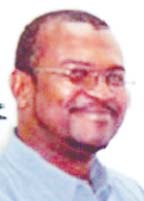
Speaking with Stabroek Business last week WWF Country Director Dr. Patrick Williams and Gold Mining Pollu-tion Abatement Co-ordinator Rickford Viera outlined a number of initiatives that have been taken by the Fund to strengthen capacity to address the environmental challenges facing the sector. At the same time, however, both WWF officials made it clear, however, that environmental transgressions in the mining sector continue to impact on the human and physical environment in local mining communities.
Dr. Williams re-ferred to two scientific studies conducted by the WWF to seek to determine the im-pact of mercury use in the mining sector on the environment. The first, in the Upper Mazaruni Basin used fish and hair samples to determine mercury residue. He said that more recently the WWF had carried out a second study at Arakaka in the North West District, in collaboration with the Institute of Applied Science and Techno-logy. (IAST). “The data that we have indicates that there is mercury in the environment and that persons have been affected by mercury use,” Dr. Williams said.

Meanwhile, Vieira told Stabroek Business that the WWF had provided funds to enable the GGMC to train its staff in environmental management, to help the Commission improve its data collection system and to enhance the agency’s skills in developing tailings management strategies in order to improve their monitoring capacity.
The WWF has also provided funding for the preparation – in March 2005- of supplementary mining regulations which addressed a number of key environmental issues including the use of tailings ponds, the use of mercury retorts, the rehabilitation of mined-out areas and the storing and handling of waste.
Vieira told Stabroek Business that the WWF had also conducted a mini survey that had revealed that several miners were unaware of the regulations. “WWF has been involved in printing copies of those amended regulations and making them available to miners,” Vieira told Stabroek Business. He said that while sensitizing miners to the new regulations was “a good first step” this initiative “must be complemented by adequate monitoring and enforcement initiatives.”
While questions have been raised about the capacity of the GGMC to effectively enforce mining regulations Dr. Williams told Stabroek Business that the enforcement of those regulations does not rest solely with the Commission. He said that what was needed was “a stakeholder approach” in which the miners and the communities join forces with the executing agency to ensure environmentally sustainable mining.
Sources in the mining sector have told Stabroek Business that among the GGMC’s principal weaknesses is its inability to enforce its own ‘stop work’ orders instituted against miners who transgress environmental and other regulations. This newspaper has also learnt that some mining operations that have been prosecuted for transgressions may have managed to ensure that their equipment remain working despite the legal action taken against them.
Sources in the mining sector have told Stabroek Business that the steep rise in the price of gold over the past two years has sparked a mining frenzy in Guyana that has resulted in far less mindfulness of the environmental regulations. “Even if the WWF is right about many miners not knowing about the amended regulations, one wonders whether they care about the regulations anyway,” the source said.
Last April WWF met with local miners to sensitize them to the impact of mining on the ecosystems, to interface with them on the problems facing the mining community and to work with them to develop improved mining practices. Vieira told Stabroek Business that the WWF was concerned with showing local miners “alternative mining techniques and better practices including mercury retort demonstrations, the development of rehabilitation plans and the creation of tailings ponds.”
Vieira said that the WWF is also involved in environmental impact monitoring designed to determine the effects of mining on the environment. “We do a fair amount of monitoring of the environment to determine mercury use, suspended solids and water quality,”
Meanwhile, the WWF will shortly be providing the Guyana Gold and Diamond Miners Association (GGDMA) with a US$30,000 grant to secure the services of a consultant to train miners in how to develop tailings facilities to contain mining waste in order to prevent the contamination of streams used by the host communities for domestic purposes.





